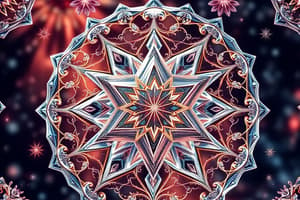Podcast
Questions and Answers
What type of structure do molecular solids have?
What type of structure do molecular solids have?
- Crystalline structure (correct)
- Polymeric structure
- Ionic structure
- Amorphous structure
In a body-centered cubic (BCC) crystal lattice, what is the coordination number?
In a body-centered cubic (BCC) crystal lattice, what is the coordination number?
- 6
- 4
- 8 (correct)
- 12
Which defect preserves overall electrical neutrality in the crystal lattice?
Which defect preserves overall electrical neutrality in the crystal lattice?
- Frenkel defect (correct)
- Stacking fault
- Interstitial defect
- Schottky defect
A compound forms hcp structure. Number of octahedral and tetrahedral voids in O.5 mole of substance is respectively
A compound forms hcp structure. Number of octahedral and tetrahedral voids in O.5 mole of substance is respectively
Pb has FCC structure with the edge length of unit cell 495 pm. Radius of Pb atom is
Pb has FCC structure with the edge length of unit cell 495 pm. Radius of Pb atom is
An Ionic compound crystallizes in FCC type structure with 'A' ions at the centre of each face and 'B' ions occupying corners of the cube. The formula of the compound is
An Ionic compound crystallizes in FCC type structure with 'A' ions at the centre of each face and 'B' ions occupying corners of the cube. The formula of the compound is
What is the relationship between the edge length (a) and atomic radius (r) in a simple cubic lattice?
What is the relationship between the edge length (a) and atomic radius (r) in a simple cubic lattice?
How many particles are present in a face-centered cubic (FCC) unit cell?
How many particles are present in a face-centered cubic (FCC) unit cell?
The relation between radius of sphere and edge length in body centered cubic lattice is given by formula
The relation between radius of sphere and edge length in body centered cubic lattice is given by formula
Schottky defect is observed in which solid among
Schottky defect is observed in which solid among
Flashcards
Molecular Solids
Molecular Solids
A crystalline solid where constituent particles are held together by weak intermolecular forces such as van der Waals forces or hydrogen bonds.
n-type semiconductor
n-type semiconductor
A semiconductor material where the majority charge carriers are electrons, created by doping with an element having more valence electrons than the host.
Frenkel Defect
Frenkel Defect
A point defect in a crystal lattice where an ion is displaced from its normal lattice site to an interstitial site, creating a vacancy.
Coordination Number
Coordination Number
Signup and view all the flashcards
Hexagonal Close-Packed (HCP) Structure
Hexagonal Close-Packed (HCP) Structure
Signup and view all the flashcards
Crystal Lattice
Crystal Lattice
Signup and view all the flashcards
Simple Cubic Lattice
Simple Cubic Lattice
Signup and view all the flashcards
Body-Centered Cubic (BCC) Lattice
Body-Centered Cubic (BCC) Lattice
Signup and view all the flashcards
Face-Centered Cubic (FCC) Lattice
Face-Centered Cubic (FCC) Lattice
Signup and view all the flashcards
Schottky Defect
Schottky Defect
Signup and view all the flashcards
Study Notes
MCQ'S
- Molecular solids are crystalline solids
- n-type semiconductor: Si doped with As
- Frenkel defect: preserves overall electrical neutrality
- Coordination number of atoms in bcc crystal lattice is 8
- A compound forms hep structures. Number of octahedral and tetrahedral voids in 0.5 mole of substance is 3.011 x 1023 (octahedral) and 6.022 x 1023 (tetrahedral)
- Pb has FCC structure, edge length of unit cell is 495 pm, radius of Pb atom is 175 pm
Studying That Suits You
Use AI to generate personalized quizzes and flashcards to suit your learning preferences.




